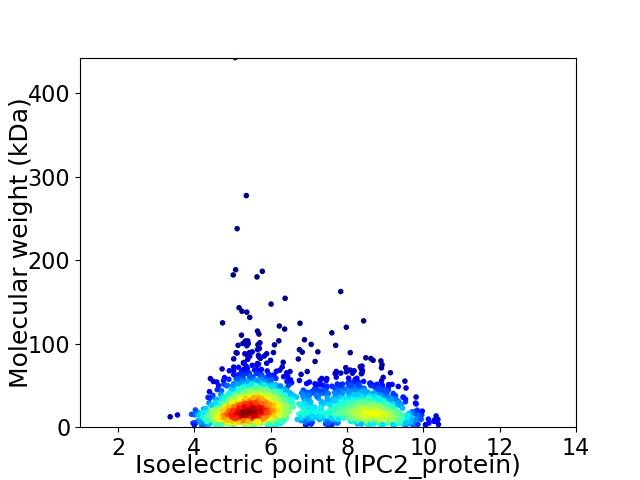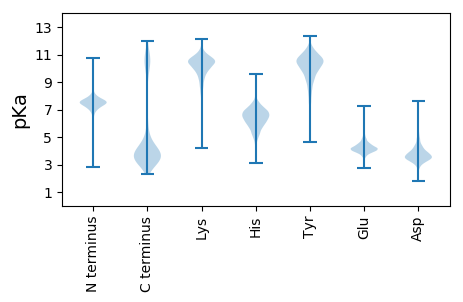
Gilliamella apicola SCGC AB-598-B02
Taxonomy: cellular organisms; Bacteria; Proteobacteria; Gammaproteobacteria; Orbales; Orbaceae; Gilliamella; Gilliamella apicola
Average proteome isoelectric point is 6.61
Get precalculated fractions of proteins

Virtual 2D-PAGE plot for 1967 proteins (isoelectric point calculated using IPC2_protein)
Get csv file with sequences according to given criteria:
* You can choose from 21 different methods for calculating isoelectric point
Summary statistics related to proteome-wise predictions



Protein with the lowest isoelectric point:
>tr|A0A080KKX4|A0A080KKX4_9GAMM Uncharacterized protein OS=Gilliamella apicola SCGC AB-598-B02 OX=1445513 GN=GASC598B02_017370 PE=4 SV=1
MM1 pKa = 7.92KK2 pKa = 10.15DD3 pKa = 3.34QIMLAQQDD11 pKa = 3.65TNAIIEE17 pKa = 4.27EE18 pKa = 4.18LLEE21 pKa = 5.15DD22 pKa = 4.64GSDD25 pKa = 3.29PHH27 pKa = 8.25ALYY30 pKa = 10.15IIEE33 pKa = 4.36HH34 pKa = 6.84HH35 pKa = 6.84ISSQNFDD42 pKa = 4.16LLEE45 pKa = 4.29KK46 pKa = 10.66VAVEE50 pKa = 4.36AYY52 pKa = 9.72KK53 pKa = 10.69LGYY56 pKa = 9.4EE57 pKa = 4.15ATDD60 pKa = 3.65PDD62 pKa = 4.57EE63 pKa = 6.02DD64 pKa = 4.28VDD66 pKa = 3.9DD67 pKa = 4.49TGNVVIGFDD76 pKa = 3.36IVAEE80 pKa = 4.26SPLNAEE86 pKa = 5.42LINAQIAEE94 pKa = 4.82IITLTNQFGVNYY106 pKa = 9.22DD107 pKa = 2.73GWGTYY112 pKa = 10.12FEE114 pKa = 5.88DD115 pKa = 5.47GSDD118 pKa = 4.31DD119 pKa = 3.95FNEE122 pKa = 4.04VDD124 pKa = 5.19DD125 pKa = 5.29NMEE128 pKa = 4.12TLHH131 pKa = 6.9
MM1 pKa = 7.92KK2 pKa = 10.15DD3 pKa = 3.34QIMLAQQDD11 pKa = 3.65TNAIIEE17 pKa = 4.27EE18 pKa = 4.18LLEE21 pKa = 5.15DD22 pKa = 4.64GSDD25 pKa = 3.29PHH27 pKa = 8.25ALYY30 pKa = 10.15IIEE33 pKa = 4.36HH34 pKa = 6.84HH35 pKa = 6.84ISSQNFDD42 pKa = 4.16LLEE45 pKa = 4.29KK46 pKa = 10.66VAVEE50 pKa = 4.36AYY52 pKa = 9.72KK53 pKa = 10.69LGYY56 pKa = 9.4EE57 pKa = 4.15ATDD60 pKa = 3.65PDD62 pKa = 4.57EE63 pKa = 6.02DD64 pKa = 4.28VDD66 pKa = 3.9DD67 pKa = 4.49TGNVVIGFDD76 pKa = 3.36IVAEE80 pKa = 4.26SPLNAEE86 pKa = 5.42LINAQIAEE94 pKa = 4.82IITLTNQFGVNYY106 pKa = 9.22DD107 pKa = 2.73GWGTYY112 pKa = 10.12FEE114 pKa = 5.88DD115 pKa = 5.47GSDD118 pKa = 4.31DD119 pKa = 3.95FNEE122 pKa = 4.04VDD124 pKa = 5.19DD125 pKa = 5.29NMEE128 pKa = 4.12TLHH131 pKa = 6.9
Molecular weight: 14.64 kDa
Isoelectric point according different methods:
Protein with the highest isoelectric point:
>tr|A0A080K635|A0A080K635_9GAMM Uncharacterized protein (Fragment) OS=Gilliamella apicola SCGC AB-598-B02 OX=1445513 GN=GASC598B02_000450 PE=4 SV=1
MM1 pKa = 7.48GKK3 pKa = 9.28IFNTNYY9 pKa = 9.57RR10 pKa = 11.84AYY12 pKa = 9.38GTRR15 pKa = 11.84RR16 pKa = 11.84LQAEE20 pKa = 4.28LRR22 pKa = 11.84KK23 pKa = 10.1QGITVSRR30 pKa = 11.84RR31 pKa = 11.84RR32 pKa = 11.84IGRR35 pKa = 11.84IMAKK39 pKa = 10.08NGWVSKK45 pKa = 6.88YY46 pKa = 7.4TCKK49 pKa = 10.4KK50 pKa = 9.37YY51 pKa = 10.7CIHH54 pKa = 6.13TEE56 pKa = 3.77KK57 pKa = 11.02SNEE60 pKa = 4.09SPVGNEE66 pKa = 3.74LNRR69 pKa = 11.84EE70 pKa = 4.03FNIGQPRR77 pKa = 11.84KK78 pKa = 9.91ILVTDD83 pKa = 3.67LTYY86 pKa = 11.18VRR88 pKa = 11.84VKK90 pKa = 10.53QRR92 pKa = 11.84WHH94 pKa = 5.38YY95 pKa = 9.94FCVIVDD101 pKa = 3.36ISNRR105 pKa = 11.84EE106 pKa = 3.64IVGRR110 pKa = 11.84SAGRR114 pKa = 11.84HH115 pKa = 3.65KK116 pKa = 9.51TAALVMQAMSQIPMNLQTIEE136 pKa = 4.73LFHH139 pKa = 7.14SDD141 pKa = 3.49RR142 pKa = 11.84GNN144 pKa = 2.98
MM1 pKa = 7.48GKK3 pKa = 9.28IFNTNYY9 pKa = 9.57RR10 pKa = 11.84AYY12 pKa = 9.38GTRR15 pKa = 11.84RR16 pKa = 11.84LQAEE20 pKa = 4.28LRR22 pKa = 11.84KK23 pKa = 10.1QGITVSRR30 pKa = 11.84RR31 pKa = 11.84RR32 pKa = 11.84IGRR35 pKa = 11.84IMAKK39 pKa = 10.08NGWVSKK45 pKa = 6.88YY46 pKa = 7.4TCKK49 pKa = 10.4KK50 pKa = 9.37YY51 pKa = 10.7CIHH54 pKa = 6.13TEE56 pKa = 3.77KK57 pKa = 11.02SNEE60 pKa = 4.09SPVGNEE66 pKa = 3.74LNRR69 pKa = 11.84EE70 pKa = 4.03FNIGQPRR77 pKa = 11.84KK78 pKa = 9.91ILVTDD83 pKa = 3.67LTYY86 pKa = 11.18VRR88 pKa = 11.84VKK90 pKa = 10.53QRR92 pKa = 11.84WHH94 pKa = 5.38YY95 pKa = 9.94FCVIVDD101 pKa = 3.36ISNRR105 pKa = 11.84EE106 pKa = 3.64IVGRR110 pKa = 11.84SAGRR114 pKa = 11.84HH115 pKa = 3.65KK116 pKa = 9.51TAALVMQAMSQIPMNLQTIEE136 pKa = 4.73LFHH139 pKa = 7.14SDD141 pKa = 3.49RR142 pKa = 11.84GNN144 pKa = 2.98
Molecular weight: 16.76 kDa
Isoelectric point according different methods:
Peptides (in silico digests for buttom-up proteomics)
Below you can find in silico digests of the whole proteome with Trypsin, Chymotrypsin, Trypsin+LysC, LysN, ArgC proteases suitable for different mass spec machines.| Try ESI |
 |
|---|
| ChTry ESI |
 |
|---|
| ArgC ESI |
 |
|---|
| LysN ESI |
 |
|---|
| TryLysC ESI |
 |
|---|
| Try MALDI |
 |
|---|
| ChTry MALDI |
 |
|---|
| ArgC MALDI |
 |
|---|
| LysN MALDI |
 |
|---|
| TryLysC MALDI |
 |
|---|
| Try LTQ |
 |
|---|
| ChTry LTQ |
 |
|---|
| ArgC LTQ |
 |
|---|
| LysN LTQ |
 |
|---|
| TryLysC LTQ |
 |
|---|
| Try MSlow |
 |
|---|
| ChTry MSlow |
 |
|---|
| ArgC MSlow |
 |
|---|
| LysN MSlow |
 |
|---|
| TryLysC MSlow |
 |
|---|
| Try MShigh |
 |
|---|
| ChTry MShigh |
 |
|---|
| ArgC MShigh |
 |
|---|
| LysN MShigh |
 |
|---|
| TryLysC MShigh |
 |
|---|
General Statistics
Number of major isoforms |
Number of additional isoforms |
Number of all proteins |
Number of amino acids |
Min. Seq. Length |
Max. Seq. Length |
Avg. Seq. Length |
Avg. Mol. Weight |
|---|---|---|---|---|---|---|---|
0 |
494925 |
20 |
3876 |
251.6 |
28.34 |
Amino acid frequency
Ala |
Cys |
Asp |
Glu |
Phe |
Gly |
His |
Ile |
Lys |
Leu |
|---|---|---|---|---|---|---|---|---|---|
6.907 ± 0.064 | 1.143 ± 0.02 |
5.376 ± 0.044 | 5.613 ± 0.058 |
4.45 ± 0.048 | 5.974 ± 0.068 |
2.075 ± 0.029 | 8.66 ± 0.057 |
6.689 ± 0.056 | 10.312 ± 0.064 |
Met |
Asn |
Gln |
Pro |
Arg |
Ser |
Thr |
Val |
Trp |
Tyr |
|---|---|---|---|---|---|---|---|---|---|
2.391 ± 0.032 | 5.76 ± 0.052 |
3.628 ± 0.035 | 4.496 ± 0.05 |
3.819 ± 0.042 | 6.432 ± 0.051 |
5.315 ± 0.032 | 6.063 ± 0.05 |
1.146 ± 0.021 | 3.75 ± 0.043 |
Most of the basic statistics you can see at this page can be downloaded from this CSV file
Proteome-pI is available under Creative Commons Attribution-NoDerivs license, for more details see here
| Reference: Kozlowski LP. Proteome-pI 2.0: Proteome Isoelectric Point Database Update. Nucleic Acids Res. 2021, doi: 10.1093/nar/gkab944 | Contact: Lukasz P. Kozlowski |
